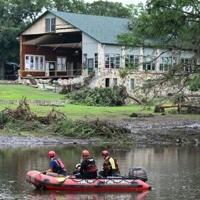Texas Floods: Misinformation Cascades Amidst Tragedy
The devastating floods that recently ravaged Texas, leaving a trail of destruction and claiming over a hundred lives, have become a breeding ground for misinformation across the social media landscape. As rescue efforts continue, a torrent of false narratives from both ends of the political spectrum has inundated online platforms, further compounding the tragedy. While legitimate concerns exist regarding disaster preparedness and response, the spread of unsubstantiated claims serves only to distract from the crucial task of providing aid and rebuilding communities.
On the left, unfounded allegations have circulated, blaming staffing cuts at the National Weather Service (NWS) under the Trump administration for supposed failures in the warning system. These claims, however, are contradicted by evidence demonstrating that the NWS issued numerous timely and accurate warnings in the affected areas, notably Kerr County, which bore the brunt of the flooding. Experts, including climate scientist Daniel Swain, have affirmed the effectiveness of the NWS forecasts and emphasized that the challenge lay not in predicting the event but in ensuring the timely dissemination of warnings to those in harm’s way – a critical “last mile” communication issue.
Conversely, right-wing conspiracy theories have taken root, promoting the baseless notion that the government intentionally induced the flooding through cloud seeding, a weather modification technique. This narrative echoes similar conspiracy theories that emerged after Hurricane Milton and the Dubai floods, lacking any scientific basis. Experts have categorically refuted these claims, stating that such weather manipulation technologies played no role in the Texas disaster.
The proliferation of misinformation from both sides of the political spectrum underscores a disturbing trend: the exploitation of tragedies to advance pre-existing narratives and sow discord. This phenomenon transcends the Texas floods, recurring after numerous natural disasters as bad actors seize upon the chaos and emotional vulnerability to spread their agendas. NewsGuard, a disinformation watchdog, has highlighted this pattern, warning that conspiracy theories about human-caused weather events often follow natural disasters, further muddying the waters in times of crisis.
The ease with which misinformation spreads online is amplified by the dynamics of social media platforms. In the aftermath of disasters, these platforms often scale back content moderation and reliance on human fact-checkers, creating a fertile environment for false information to flourish. The emotional charge surrounding these events further exacerbates the problem, as users are more likely to share emotionally resonant content without verifying its accuracy. This rapid spread of misinformation can hinder relief efforts, create unnecessary panic, and erode public trust in vital institutions.
Even traditional media outlets have fallen prey to the misinformation swirling online. Kerr County Lead, a local publication, retracted a story about a miraculous rescue of two girls clinging to a tree, demonstrating the challenges even reputable news sources face in navigating the deluge of unverified information. The incident serves as a cautionary tale, underscoring the need for rigorous fact-checking and verification, particularly during rapidly unfolding events. While the desire to share uplifting stories is understandable, it is crucial for journalists to prioritize accuracy and avoid contributing to the spread of false narratives.
The Texas floods underscore the urgent need for heightened media literacy and critical thinking skills among social media users. In the face of a crisis, the ability to discern credible information from fabricated narratives can be life-saving. Fact-checking organizations, news outlets, and social media platforms all have a crucial role to play in combatting misinformation and ensuring that accurate information reaches those who need it most. As natural disasters become increasingly frequent and severe due to climate change, the challenge of navigating a landscape saturated with misinformation will only grow more acute.


